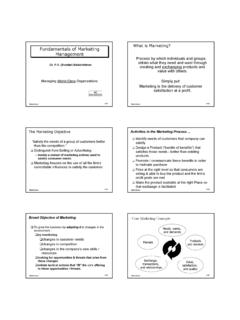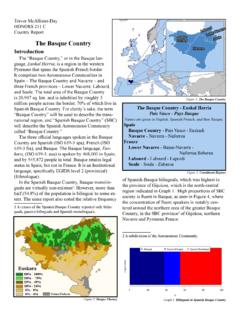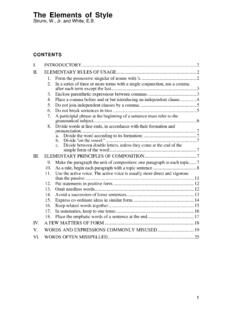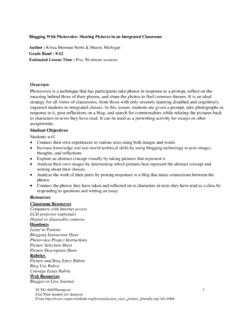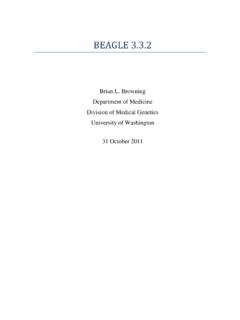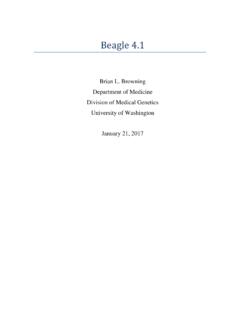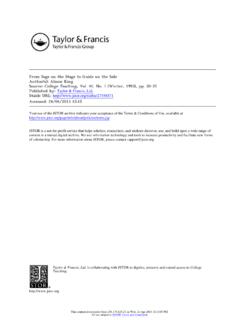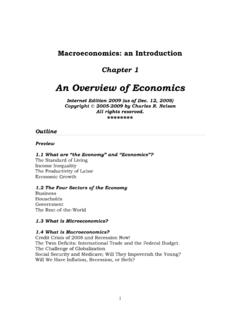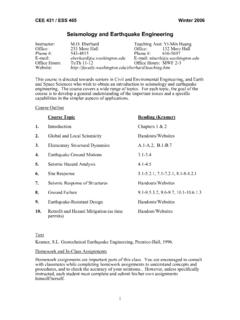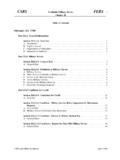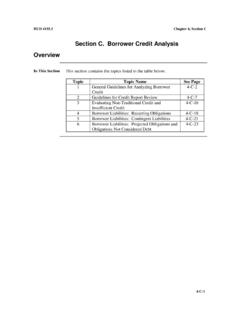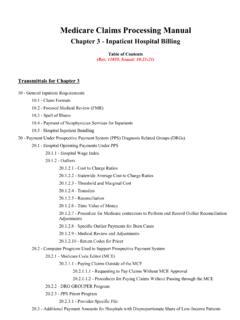Transcription of Chapter 12 The Balance of Payments and the Exchange Rate
1 Chapter 12 The Balance of Payments and the Exchange Rate In today's global economy world, the phenomenon of the "closed economy" one that is unaffected by international trade and capital flows is little more than an abstract textbook concept. The notion of a closed economy is nevertheless quite useful in intermediate macroeconomics, as it allows for the analysis of the fundamental aspects of the economy ( the impact of monetary and fiscal policy) without considering the complicating effects of globalization. With the fundamentals well understood, however, we can now provide more realism by looking at the open economy that is directly affected by global marketplace. Considering an economy as part of the global marketplace adds complexity to our model. The first bit of complexity comes in form of new terminology and concepts.
2 We shall start by introducing the two fundamental concepts of the open economy: the Balance of Payments (BoP) and the Exchange rate. These two notions are both elementary and extraordinarily powerful in providing rich insights into the workings of an international economy. The Balance of Payments usually is compiled by each country s central bank or finance ministry. In the US, the Balance of Payments is compiled by the Bureau of Economic Analysis (US Department of Commerce) under the heading International Transactions 1 See In the UK International transactions are at Learn ing objectives By the end of this Chapter you should be able to understand: the Balance of Payments as an accounting device recording the nation transactions with the rest of the world the Balance of payment double entry system insuring that it always balances which transactions are debit entries and which are credit the difference between the goods (merchandises) Balance , the Balance of trade, and the current account the link with chronic trade deficits and foreigners acquiring domestic assets the close link between the Balance of Payments and the international investment position of a country the Exchange rate as the relative price of foreign currency the importance and applications of the real Exchange rate and the real effective Exchange rates International Transactions Accounts The Balance of Payments (BoP)
3 Is the international Balance sheet of a nation that records all international transactions in goods, services, and assets over a year. That is why this BoP is usually under the International Transactions Accounts in national statistical data. The BoP is that of a simple accounting tool, similar to Balance sheets of companies that report transactions such as goods bought and sold, or assets borrowed and acquired. After we have studied all components of the BoP, we will find that it serves as the most important statistics in the open economy since it summarizes exactly how the domestic economy interacts with the rest of the world. Key Components of the Balance of Payments The BoP is broken down into three important sub-components: the current account Balance (CA), the capital account Balance (KA), and the financial account Balance (FA): FAKACABoP++= ( ) Table shows the entire BoP with all its sub-components for the US in 2006.
4 We will discuss each major sub-components in detail below, but for now we want to keep in mind that the current account represents basically trade in goods and services and the financial account collects information on financial transactions such as international stock and bond purchases. Finally, the capital account keeps track of all the flow of non-financial assets, such as the transfer of intellectual property rights. Changes in each sub-component will have a different impact on the domestic economy. Recall that we labeled the BoP an international Balance sheet, and just like the accounting in any other Balance sheet, the BoP is tracked using double-entry accounting. Double-entry accounting means that every transaction enters the BoP twice, once as a credit (+), for example the export of a car to foreigners, and once as a debit (-), which is how you would record the Payments for the car.
5 Therefore the BoP is actually an identity: 0!++=FAKACABoP ( ) The sum of all the entries in the three sub accounts (CA, KA, FA) must be equal to zero since every entry has a counterpart with the opposite sign in some other section of the BoP. Table : Main Categories in the US Balance of Payments Data for 2006 in millions of dollars Credit (+); Debits (-) Current account: Exports Goods (1) 1,023,689 Services (2) 413,127 Income receipts (3) 622,020 Imports Goods (4) -1,859,655 Services (5) - 342,428 Income Payments (6) - 629,286 Net Unilateral current transfers (7) - 84,122 Capital account (8): - 3,914 Financial account: Net assets abroad (9) - 1,045,760 Other government assets 5,219 direct investments (FDI) - 248,856 Foreign securities (PI) - 277,691 Other - 526,806 Net Foreign owned assets 1,464,399 direct investments (FDI) 183,571 securities (PI) 650,571 Other 630,257 Net Foreign official assets in the 300,510 Net Foreign-owned assets in the (10) 1,764,909 Net Foreign official assets in the 300,510 direct investments (FDI) 183,571 securities (PI) 650,571 Other 630,257 Net official reserve assets 2,374 Statistical discrepancy 141,419 Calculation of Important Balances.
6 Goods Balance (GB) (1) + (4) -835,966 Service Balance (SB) (2) + (5) 70,699 Net income receipts (NIR) (3) + (6) - 7,266 Trade Balance (TB) (1) + (2) + (4) + (5) 765,267 Current account Balance (CA) (1) through (7) -856,655 Balance on financial accounts (FA) (9) + (10) 719,149 The Current Account The current account consists of the goods Balance (GB), the service Balance (SB), net income receipts (NIR), and net international transfers (IT). CA=GB+SB+NIR+IT ( ) We will explain each component of the current account separately below. Starting with the goods Balance , it is important to remember that trade in goods refers only to physical goods that cross a border. In this sense the trade Balance in physical goods is equivalent to a net flow of goods. When more goods flow out of a country (are exported) than flow in (are imported), the GB will be in surplus.
7 To avoid confusion, it is crucial to introduce the definition of BoP debits and credits: a BoP credit is a positive entry into the BoP and it represents an international transaction that generates a receipt, for example, via an export, or an interest payment on a foreign bond. In contrast, a debit is a negative entry into the BoP and it represents transactions that give rise to a payment from the domestic economy to foreigners, for example through an import, or a dividend for domestic stocks held by foreigners. Since exporting involves shipments of merchandise from the domestic economy to a foreign country to receive payment in return, exports are reported as a credit, and the exporting country finds itself with a positive GB (a surplus) if merchandise exports are greater than imports.
8 Where does the US stand as far as the goods Balance goes? For a number of years now the US posted the worlds largest deficits in the goods Balance . IN 2006 the US exported about one trillion dollars of goods and imported $ trillion to generate a whopping $800 billion dollar deficit. Figure shows the evolution of the US goods Balance and its components since 1980. It shows that imports are increasingly outpacing exports of goods in the US at a breathtaking pace. In open economy macroeconomics, we study the impact of such a magnificent goods Balance deficit on the domestic economy. Figure : US Goods Balance 1980-2006 -1000000-5000000500000100000015000002000 0001980198219841986198819901992199419961 9982000200220042006 Exports of GoodsImports of goodsGoods Balance Source: The service Balance refers to the travel and transportation services as well as financial, accounting, legal, and other services that are tradable across countries.
9 Conceptually, the exports and imports of services are analogous to exports and imports of goods. The exact sub-components of the service account can be found in Table at the end of the Chapter , which reproduces the entire 2006 BoP for the US. A service is entered as a credit when a nation contracts out ( exports ) its domestic labor to provide, say, legal services to a company in a foreign country. Conversely, a service is recorded as a debit when a nation contracts for ( imports ) foreign labor to provide, say, financial services to the domestic economy. As with the goods Balance , the services Balance is equal to exports minus imports of services. In contrast to the deficit in its goods Balance , the US, like most developed nations, exhibit a surplus in its services Balance . Most industrialized nations have developed an extensive service sector, to the point where manufacturing constitutes less than 50% of the economic activity.
10 It is this highly developed service sector explains why the US is running a service Balance surplus. However, the magnitude of the service Balance surplus (about $400 Billion) is dwarfed by the goods Balance deficit in the US. The sum of the goods Balance and service Balance is called the trade Balance (TB), which is also perhaps the sub-component of the BoP most often quoted by the press and by politicians. On a quarterly and even monthly basis, news agencies eagerly await the release of the latest trade Balance data as it provides a quick look at the international competitiveness of the country. TB=GB+SB ( ) The trade Balance is calculated by subtracting all imports of goods and services (M) from the exports of goods and services (X). If a country s imports exceeds its exports (X-M<0) it is said to be running a trade deficit.
